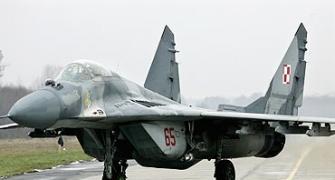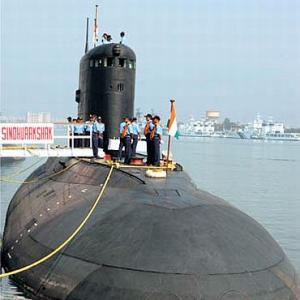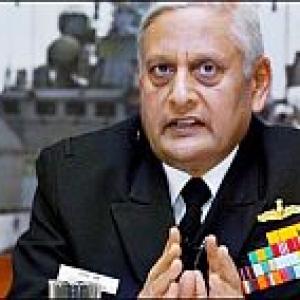The fire mishap on INS Sindhurakshak in Visakhapatnam that left a sailor dead and two others injured was caused by an explosion in its battery compartment, Navy officials said in New Delhi on Saturday.
Sindhurakshak, a Russian-origin Kilo class submarine, was in the Visakhapatnam harbour for a routine maintenance when the mishap occurred on Friday evening.
"It was due to a defective battery and Leading Electrical Technician Kump Dand was killed," the official said.
India had bought the 2300-tonne submarine from Russia as part of an early 1980s deal and commissioned it in 1997. It is the ninth of the 10 Sindhugosh class diesel-electric powered vessel that the Navy has in its 16-vessel submarine fleet.
Sindhurakshak is scheduled for a major mid-life refit later this year as part of a programme for this class of vessels, which began in 1997 with Sindhuvir.
In January 2008, another vessel from this class, INS Sindhugosh, collided with a merchant vessel off Mumbai while participating in a naval exercise.
The boat collided with the cargo ship as it was surfacing in a silent mode with its radio and radar switched off.
The damage caused to the submarine during the mishap resulted in it being off service for about a month.
The Navy has been worried over its fast-depleting submarine fleet and by the delays in the construction of the six Scorpene submarines at the Mumbai-based Mazagon Docks and the long time taken in identifying a shipyard to order the second line of submarine construction.
The Navy currently operates 16 submarines, of which two are Foxtrot class boats acquired since 1967 and having served three times their service life already.
Another four are HDW class submarines, commissioned since 1986.
The Navy fears the submarine fleet strength would fall by 30 per cent in 2015 and 50 percent by 2020 at the current pace of acquisitions and in the event of any further delays in delivery of Scorpene and construction of the second line of submarines.
Although construction of Scorpenes was planned for 2000-2012, even the first of the six boats is yet to be completed and has been delayed by around two years.
At present, it is projected that the six vessels would be completed only by 2017.
India's 30-year plan for acquiring 24 submarines was approved by the Cabinet Committee on Security in 1999, with six Scorpenes under Project 75, six more submarines under Project 75I, and the remaining 12 to be constructed indigenously, provided the country acquire the expertise, technology and capability to do so by then.
India has also launched the first of its nuclear-powered submarine, INS Arihant, at Visakhapatnam in July last year and it is likely to enter service in the first half of next decade.
It is also getting a Russian nuclear-powered submarine on a 10-year lease by June this year.







